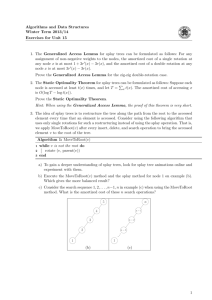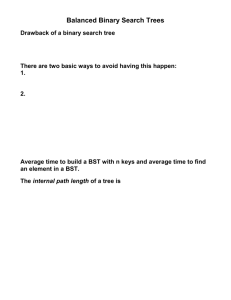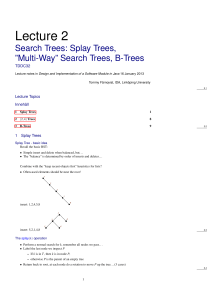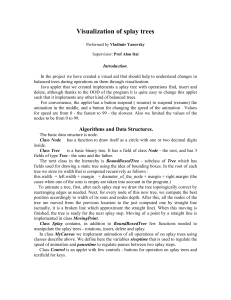Massachusetts Institute of Technology Handout 6 6.854J/18.415J: Advanced Algorithms
advertisement
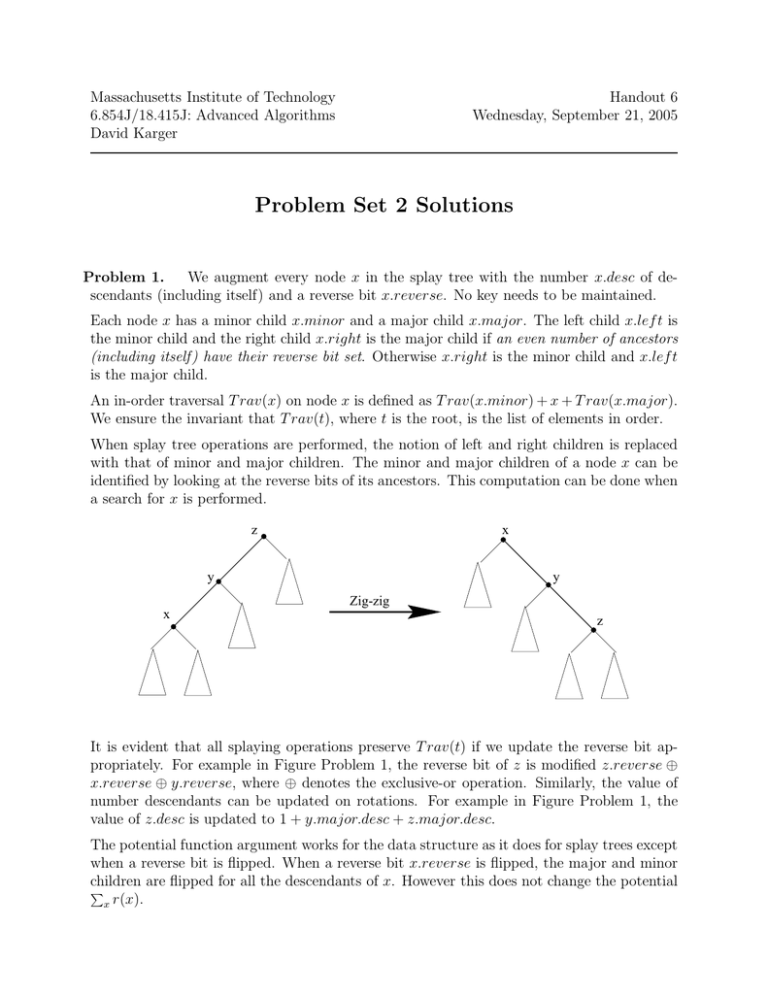
Massachusetts Institute of Technology 6.854J/18.415J: Advanced Algorithms David Karger Handout 6 Wednesday, September 21, 2005 Problem Set 2 Solutions Problem 1. We augment every node x in the splay tree with the number x.desc of descendants (including itself) and a reverse bit x.reverse. No key needs to be maintained. Each node x has a minor child x.minor and a major child x.major. The left child x.lef t is the minor child and the right child x.right is the major child if an even number of ancestors (including itself ) have their reverse bit set. Otherwise x.right is the minor child and x.lef t is the major child. An in-order traversal T rav(x) on node x is defined as T rav(x.minor) + x + T rav(x.major). We ensure the invariant that T rav(t), where t is the root, is the list of elements in order. When splay tree operations are performed, the notion of left and right children is replaced with that of minor and major children. The minor and major children of a node x can be identified by looking at the reverse bits of its ancestors. This computation can be done when a search for x is performed. z x y y Zig-zig x z It is evident that all splaying operations preserve T rav(t) if we update the reverse bit appropriately. For example in Figure Problem 1, the reverse bit of z is modified z.reverse ⊕ x.reverse ⊕ y.reverse, where ⊕ denotes the exclusive-or operation. Similarly, the value of number descendants can be updated on rotations. For example in Figure Problem 1, the value of z.desc is updated to 1 + y.major.desc + z.major.desc. The potential function argument works for the data structure as it does for splay trees except when a reverse bit is flipped. When a reverse bit x.reverse is flipped, the major and minor children are flipped for all the descendants of x. However this does not change the potential � x r(x). 2 Handout 6: Problem Set 2 Solutions Therefore we can perform splay operation correctly in O(log n) amortized time. Split and join operations can be defined on our structure. The removal or addition of a root only causes changes to the new root. We can perform access(k) by a search based on desc field. Operation insert(k, x) is done like a splay tree insert, using split and join. The reverse(i, j) involves flipping x.reverse where x is the subtree containing the range [i, j] as its descendants. To obtain an x of this form, we split at i and then at j. We now have x as the root of a splay tree. After flipping x.reverse, the three trees can be joined. Problem 2. Observe first that the claim in the question is not true for n = 3; it is not possible to turn a zig-zig into a zig-zag by splaying (try it). Claim: For n ≥ 4, it is possible to turn any n node binary search tree into any other by a sequence of splay operations. Proof: We will prove this claim by induction on n. Base case: n = 4. We can turn the tree into a left path by splaying on the items in order. (It is easy to show this for all n by induction. The key observation is that the last step of each successive splay must be a zig or zig-zag, which pushes the root onto the left path.) This is true for all n It remains to check that we can turn a left path into anything: d c c c b b a a d d c c b a a d b b c d a c d b a d d c c a a d b b a d d c b a a c c b d c b b c b a b b a d d c d d a a a c a a a d d b Handout 6: Problem Set 2 Solutions 3 Inductive step: We need to show that if it is possible to restructure any n − 1 node binary search tree into any other by a sequence of splay operations then the same is true for any n node binary search tree. We will accomplish this goal via the following four lemmas: Lemma 1 Any node in a binary search tree with ≥ 4 nodes can be moved to a leaf position by an appropriate sequence of splay operations. Lemma 2 A leaf node will remain a leaf node under a sequence of splay operations if it is not splayed. Lemma 3 The structure of the tree containing the descendants of a node that is splayed has no effect on the structure of the tree that results. Lemma 4 No two binary search trees on n nodes differ only in the position of one leaf node. By Lemma 1 we can pick a node that is to become a leaf in the final tree and make it a leaf. Now Lemmas 2 and 3 say that this leaf will stay a leaf if we splay the other nodes, and will not affect the results of splaying on the other nodes. Thus by the inductive hypothesis we know that we can restructure the other n − 1 nodes to match the desired tree. Finally, by Lemma 4 we know that we have gotten the desired tree. Proof of 1. Let i denote the item we wish to turn into a leaf. If i is the minimum item we can turn it into a leaf by splaying on i and its successor. If i is the maximal element we can handle it symmetrically. If i is not the second element, splay i’s predecessor’s predecessor, i’s, predecessor, i, and i’s successor, giving the following situation: j splay at g g j i h g h i If i is the second element we can handle it symmetrically. (Splay succ(succ(i)), succ(i), i, pred(i), and then succ(succ(i) again.) Proof of 2. It is clear from the definition of splaying that no leaf node is ever given a descendant unless it is splayed. Proof of 3. It is clear from the definition of splaying that descendants of a splayed node have no effect on the result of the operation. Proof of 4. Suppose two binary search trees differed only in the position of one leaf node. Then the path from the root to the leaf differs in these two trees. Look at the place where it 4 Handout 6: Problem Set 2 Solutions first differs. In order for the path to go left at this point the leaf must be less than this node; in order for the path to go right the leaf must be greater than this node. It is impossible for both of these to happen. Contradiction. Several people misinterpreted this question by assuming that they could just apply the zig, zig-zig, and zig-zag cases at will. A splay operation applies the three cases as appropriate until the item is at the root. So splay(x) always brings x all the way to the root. Thus you cannot just splay in subtrees, and inversion of splays is difficult. (This theorem implies that you can invert splays, but you can’t use this theorem to prove itself.) Problem 3. Let m be the number of accesses made, and let p(x) · m be the number of accesses made to item x. The access time has a information theoretic lower bound of � Ω(m x −p(x) log p(x)). It takes Ω(m) to process the sequence. Therefore the optimal � access time is Ω(m + m x −p(x) log p(x)). k 1. Search data structure Sk holds 22 most frequently accessed items. Lemma 5 The search data structure is statically optimal. Proof. There are at most 1/p(x) items with more access frequency than x. Therefore x must belong to an Sk such that k−1 22 < 1/p(x) i.e., 2k < 2(1 − log p(x)). Therefore the search time in Sk is O(2k ) = O(1 − log p(x)). The search time in smaller Si ’s is O(20 + 21 + · · · + 2k−1 ) which is O(2k ). So the total � access time is O(m + m x −p(x) log p(x)) which matches the lower bound. k 2. We make the data structure dynamic. Sk now holds the 22 most frequently accessed items that have been accessed at least once previously. The search data structure is k still optimal in search time since Sk still holds at least 22 most frequently accessed items that can be accessed by the subsequent search. The items in Sk are also organized in a search tree in the increasing order of access frequencies. It can be seen that every insert or delete operation in Sk will still take O(2k ) time. Item x in inserted in Si if p(x) of x is more than the minimum access frequency in Si . If the bucket Si is full, the item with minimum access frequency is deleted. Notice that the deleted item will be present in a higher Sj data structure. A new Sl+1 needs to be created if Sl cannot hold all elements after an insert. The creation of this level costs O(n log n) time. We will now show that the cost of insert is O(log n) amortized. Lemma 6 The amortized cost of insert operation is O(log n). Handout 6: Problem Set 2 Solutions 5 Proof. The cost of insertions in each level is O(20 + 21 + · + 2l ) = O(2l ) = O(log n) l since 22 ≥ n. The cost of creating a new level is O(n log n). But we have to create l a new level only if n = 22 . We define the potential function l−1 φ = 2l+1 · # elements in Sl − 22 where Sl is the last search data structure. The change in potential if a new level is not created is only 2l+1 . The change is potential if a new level is created is l l−1 2l+1 (22 − 22 l ) ≥ 2l · 22 = n lg n which pays for the cost of creating a new level. 3. Recall that in (b), the access frequencies were organized in a search tree for each Sk . The data structure now updates values in the search tree on accesses and maintains the current access frequency of every element in Sk . Lemma 7 The dynamic online data structure is statically optimal. Proof. The cost of the jth search is O(log(j/f (x, j))), where f (x, j) is the current access frequency of item searched. Therefore the total time to process the access sequence is T (m) = � O(log(j/f (x, j))) x = O(log(m!/ � (mp(x))!)) x � Let us denote mp(x) by mx . Note that approximation of factorials, we get � T (m) = O log � � x mx = m. By plugging in the Stirling mm−1/2 e−m � m −1/2 mx x e−mx � � mm = O log � mx + log mx x mx x � � mm = O log � mx + m x mx � since x x log mx = O(m). 4. Instead of holding the most frequently accessed items, we hold the most recently accessed item. We can replace the search tree on access frequencies by a doubly linked list holding the items in LRU order. The proof that working set theorem is satisfied is similar to lemma 5. 6 Handout 6: Problem Set 2 Solutions Problem 4. See the diagrams on the webpage. Problem 5. (a) We append a unique terminator to the end of each text; in particular, the text Ti becomes Ti $i . Now we construct the combined suffix tree in the following manner. First, construct the suffix tree of the text T1 using the McCreight’s algorithm as described in the lecture. After that, we will add all the suffixes of T2 , then all the suffixes of T3 , and so forth. To add all the suffixes of T2 , we first slowfind the text T2 (i.e., the string consisting of the entire text). We will eventually fall off the existing tree. After that, we can just run McCreight’s algorithm to insert the rest of the suffixes of T2 . Note that, we will still have the invariant: that after each step, except for the newly created leaf and possibly its parent, every explicit node of the tree has a suffix link to some other explicit node of the tree. The rest of the proof of correctness and runtime of the McCreight’s algorithm is still the same. Specifically, the time to insert all the suffixes of T2 in the common suffix tree will be O(|T2 |). In a similar way, we add all the suffixes of T3 , then all the suffixes of T4 , and so forth. Total running time will be O(|T1| + |T2 | + . . . + |Tn |). (b) Let s be the string corresponding to the node N (i.e., s is the string on the path from the root to N). Then, if s is a substring of a text Ti , then there is a suffix sw$i in Ti . This means that $i is present on some edge in the subtree rooted at N (more specifically, $i is the last symbol of an edge leading to a leaf in N’s subtree). Thus, s is a common substring of all n texts iff all $i , i = 1 . . . n, are present in the subtree rooted at N. (c) Construct a common suffix tree of texts T1 and T2 . From this suffix tree we compute the longest common substring as follows. 1. Mark every suffix tree node that contains in its subtree a suffix ending in $1 . This can be done in linear time by performing a postorder traversal of the tree: when we examine a node, we have already checked all its children; mark the node if any of its children is marked. Similarly, mark every suffix tree node that contains in its subtree a suffix ending in $2 . 2. With one more tree traversal, find the deepest node marked with both features. Just maintain a “current depth” counter; increment it by the length of any edge traversed downward and decrement by the length of any edge traversed upward. (Note that by the “depth” of a node N, we mean the length of the string corresponding to N.)
